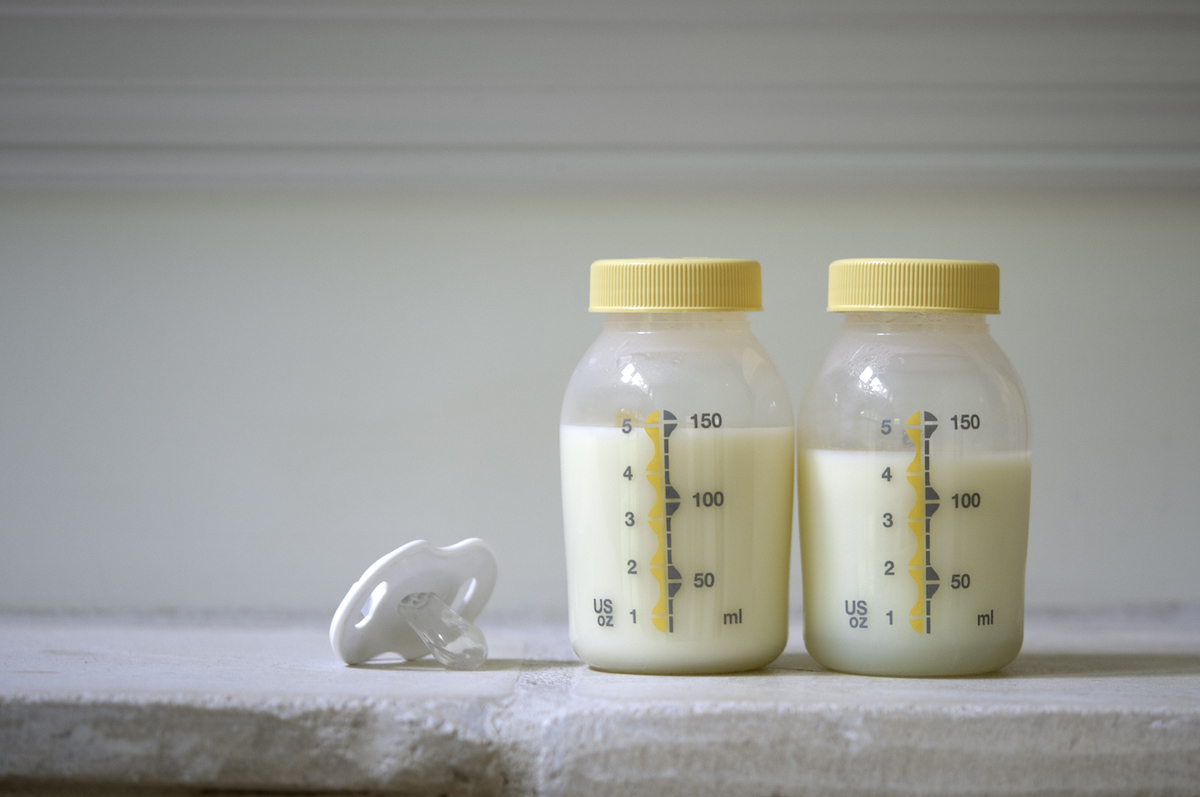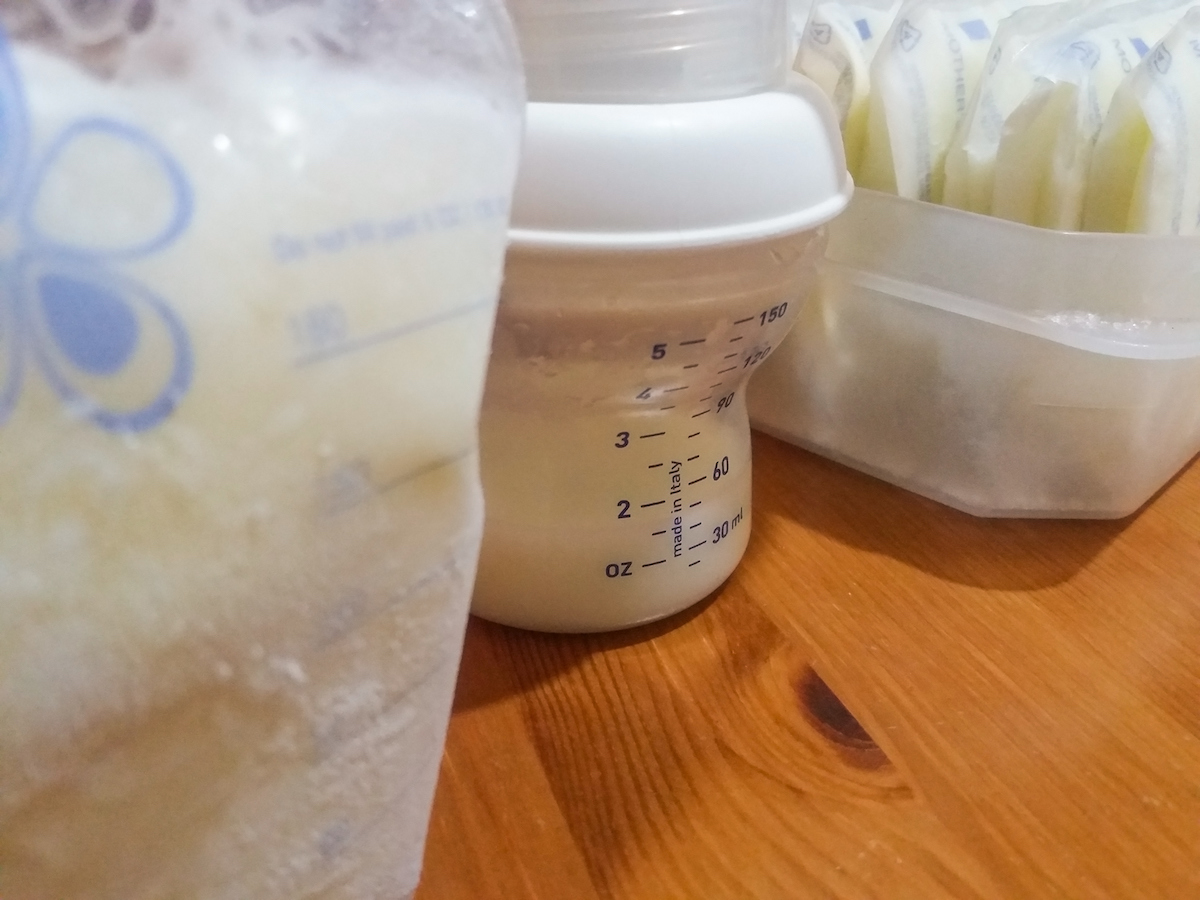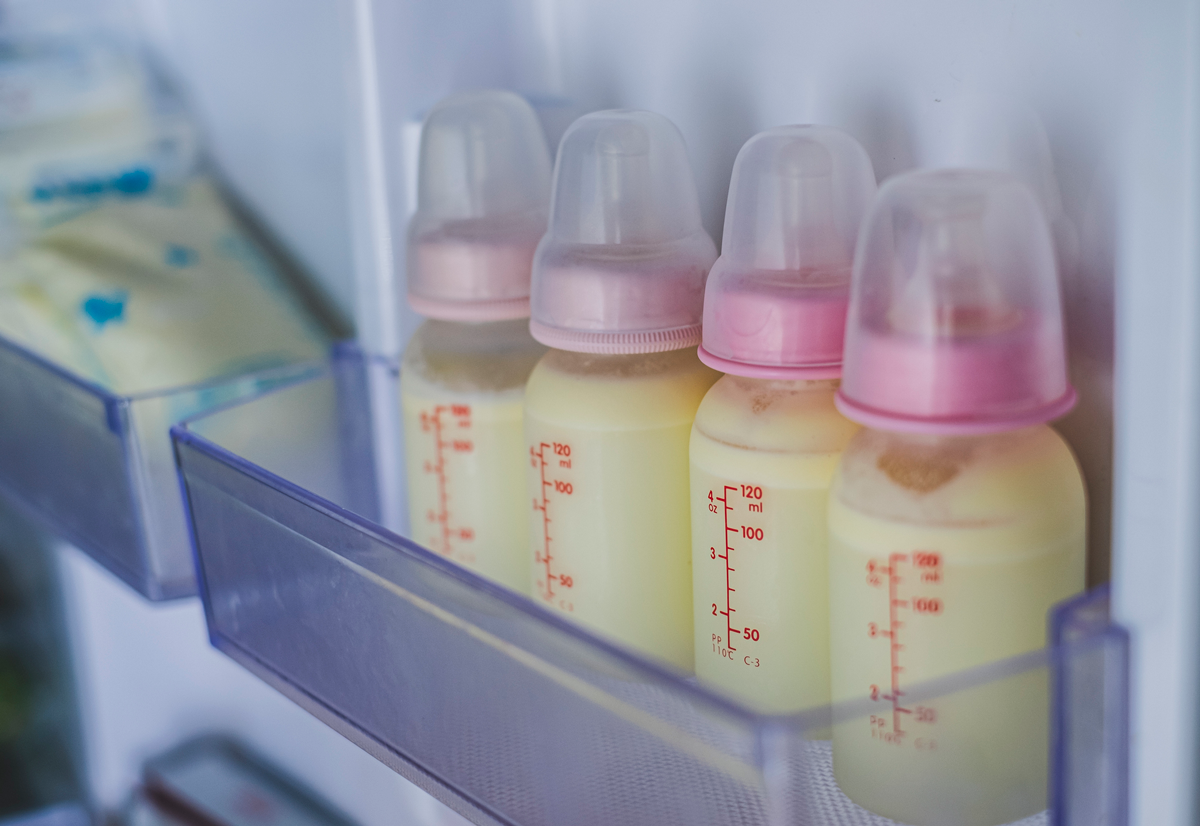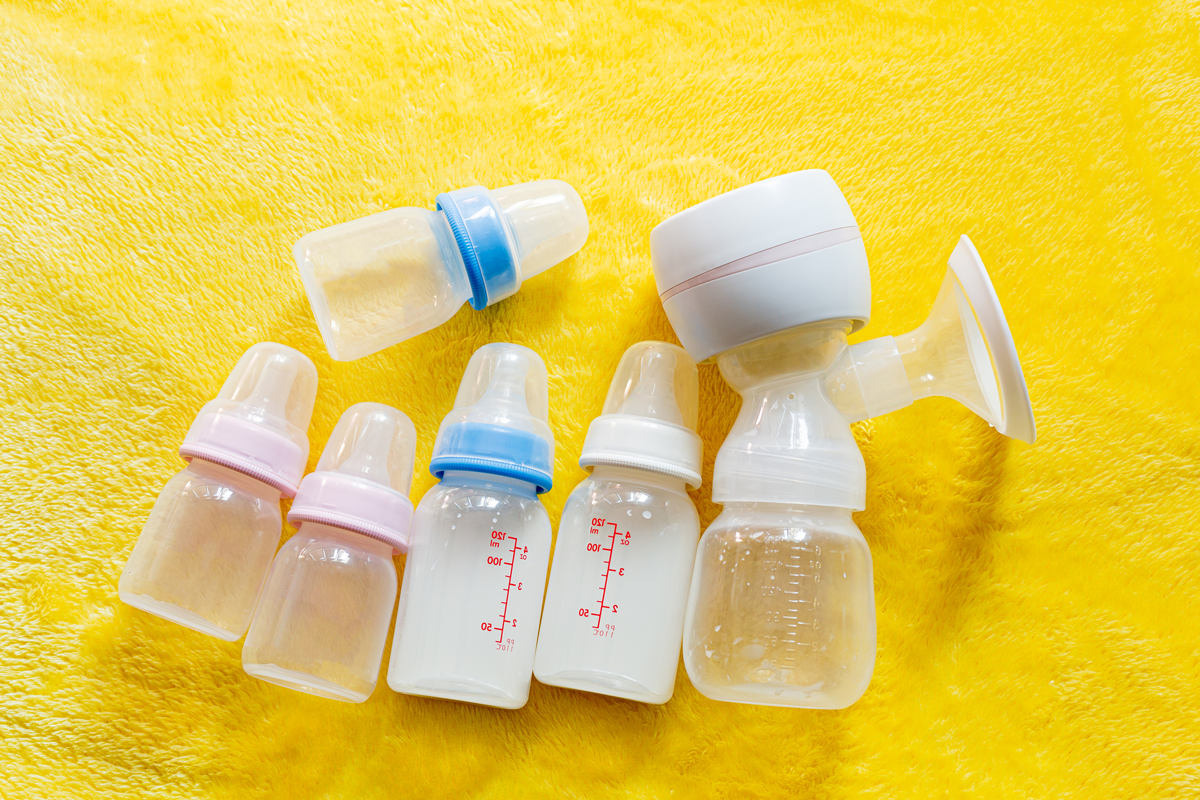One thing you’re not told about breastfeeding is that the logistics are a pain in the butt. This is especially true if you’re pumping and feeding with bottles. It is easy to become consumed with the complexities of storage and freezing and mixing and using. In our house, we had a pretty complicated rotation system for bottles — trying to make sure there was enough milk, but not so much that it spoiled.
On top of this, there is the constant fear of wastage. I’d venture many of us who pumped at work have the memory of moving a little too quickly and finding milk spilled on our desk, computer, and clothes. It’s sticky, and the effort was for naught. But wastage can also come from an open freezer, or from a baby who wasn’t really as hungry as they seemed to indicate and only drank two ounces from a four-ounce bottle.
The CDC has extremely strict rules for breast milk. It can be left for four hours at room temperature, four days in the fridge, or up to 12 months (six months is better) in the freezer. You should never refreeze once defrosted. Do not mix multiple temperatures of breast milk together (i.e. do not add warm milk to cooled milk). And if you start a bottle, use the rest within one to two hours or throw it away.
In an ideal world, with unlimited milk supplies and no logistical problems, these seem like plausible regulations. But in the real world, they can be a challenge. As a result, among the most common questions I get are: What is the data behind this? What if I — heaven forbid — put the bottle back in the fridge and fed my kid again with it four hours later: what would actually happen?
Today I’m going to dive into this whole landscape of breast milk storage and usage. I talked a couple of years ago about refreezing, but we’ll revisit that here. And we’ll also talk storage times, mixing, and re-using a partially used bottle.
(I am very focused on storage today, but to the semi-related question of whether you can shake breast milk, the answer is yes, and there is more on that here.)
Big picture: bacteria in breast milk
Underlying all of these CDC rules is the concern about bacteria. Breast milk, like all substances, has bacteria in it. These can come from the breast, from the air, from handling, etc. If the bacteria is pathogenic (say, something like staphylococci) and if it multiplies to high enough levels, it could make a baby sick. It is important to note that levels matter here. There is bacteria everywhere, in everything, even some bad bacteria. And at low levels, that’s okay.
There are guidelines about how high those concentrations can be before they cause a problem. Generally, freshly pumped breast milk has low concentrations of bacteria — far, far below the level that would be an issue. When breast milk is stored, bacteria have a chance to multiply. This growth is faster at higher temperatures. In addition, if you start with more bacteria, the load is higher even with the same growth rate.
It is widely understood and accepted that if you left breast milk out on the counter in the summer for four days, it would be spoiled. It would smell bad and taste bad and possibly be dangerous. It’s also widely accepted that leaving it out for an hour is fine. The question, on all of these exposures, is where the line is. What does the data say about whether these CDC guidelines are necessary to keep bacterial growth low enough to be safe?
Question 1: How long can breast milk be left out or stored?
The answer to this question is necessarily going to depend on the temperature. Bacteria grow more quickly when it’s hotter.
This question is eminently answerable, since we can study breast milk directly. An exemplar paper is this one, which took samples of milk from 16 women and studied their bacterial growth at varying temperatures and time frames, up to 24 hours. In these data, the researchers showed that at a temperature of 59℉, there was minimal bacterial growth by 24 hours. At 77°, though, the minimal growth was maintained only for four to eight hours. At 100°, even four hours saw considerable growth.
This suggests that even in quite a hot room, a period of storage in the range of four to eight hours would be acceptable. Similar data from Nigeria showed that storage for nine hours in tropical conditions (i.e. left out) did not generate bacterial loads that exceeded acceptable levels.
At refrigerator temperatures, storage is considerably longer. This review article points to no appreciable bacterial growth at four days with storage at typical fridge temperatures. In the freezer, measurements at six weeks and longer do not show bacterial growth. Generally, the concerns with long-term freezing are a slow decline of vitamins, and also eventually the breast milk taste is affected.
What we have from this literature is a sense that over some reasonable period (several hours left out, at least several days in the fridge), breast milk bacterial loads are stable. What we do not have is much of a sense of limits. In the studies of the refrigerated milk, we see little bacterial growth at four days. Does this mean eight days is fine? Twelve? Longer-term analysis of the question of Where is the limit? is missing.
Question 2: Can I refreeze breast milk if it thaws?
This question is especially important, in my view, because sometimes breast milk thaws by accident. When I wrote about this last time, it was in response to many people asking what they should do if someone in the house left the freezer door open and the milk defrosted overnight.
This is a question that can be studied using donor milk in carefully controlled conditions, as in this 2006 paper. The authors look at both bacterial load (a measure of pathogens) and vitamin and fatty acid content in milk treated in various ways. In addition to their analysis of storage without freezing, they also consider what happens if you take milk that’s frozen, thaw it, and refreeze it.
The frozen-thawed-frozen milk does not show an appreciable bacterial load — it is an order of magnitude lower than the FDA limits. A 2016 review article draws broadly similar conclusions, though notes that deep freezing for lengthy periods may impact nutritional content (calories and fat).
There is some human judgment here — if the freezer is left open while you’re on a two-week-long trip, you do not want to refreeze the milk. But if it’s open overnight and everything thaws a bit, there is nothing in the data that would suggest you need to throw it away. Just close the freezer and try to move on.
Question 3: Can I mix multiple temperatures of breast milk?
Let’s say you are like me and you are not a prolific breast milk producer. I used four-ounce bottles when I pumped, but let’s not kid ourselves that I was ever producing that much at once. Sometimes there would be half-filled bottles. Was it okay to combine the new two ounces, still warm, with the old?
The guidelines say no. Many people wonder why. The simple reason is that this will warm up the cold milk. When it is warmer, it’s more susceptible to bacteria growth. However: we established at the top that generally breast milk is quite stable, and storage even at room temperature can happen for a fairly long time. Adding breast milk to a bottle, therefore slightly warming it for a brief period, while leaving it in the refrigerator — this is a very small change.
Put differently: if you think of yourself as having six to eight hours of room-temperature storage before you get concerned, the briefly warmer period while the milk comes to the same temperature can be counted against this amount of time. All in all, this risk is entirely theoretical at best.
Question 4: Can I re-use it after having used some?
This is in many ways the most interesting question. When your baby drinks from a bottle, bacteria from their mouth get into the milk. For this reason, the baseline bacterial load will be higher right after they’ve drunk the milk compared with right before. The larger bacterial load will mean, of course, more possibilities for bacterial multiplication. This is why the CDC recommends throwing the milk away.
On the other hand, this is also the most interesting question from the standpoint of your life. It’s really, really frustrating to throw away pumped milk.
This question is, in principle, answerable. What you’d need to do is have some babies drink breast milk and measure the bacterial content before drinking and then after drinking and storing for various lengths of time.
When I went looking for evidence like this, the first thing I found was evidence on formula. I wrote about this during the formula shortage. There are at least two recent academic papers (here and here) that had adults drink baby formula and then measured the bacterial content of the formula after drinking and then after storage. In these cases, even after up to 24 hours of storage in the fridge, the samples did not produce high bacterial levels.
This is encouraging, but it’s about formula and not breast milk. However, we have other evidence that breast milk is much less prone to bacterial growth than formula. Putting these facts together, we would rationally conclude that the safe storage time of partially drunk breast milk might be higher than partially drunk formula.
None of this published work, though, does the analysis we want on breast milk. In my searching, though, I did find one absolutely amazing article — an undergraduate senior thesis from 1998 — in which the author did precisely what I wanted. She recruited six women with babies and had them feed their babies from bottles of pumped milk. She tested the milk before feeding and after feeding and then after storing it in the fridge for up to 48 hours. She looked for bacterial colony counts in various ways.
The author of this article does many things that I think are really excellent. She basically tries to get the women to express and store milk in a normal way. The milk is stored in their regular refrigerators. She uses bottles cleaned in the dishwasher “because this is the method many women use to clean their bottles.”
Anyway, here is what she finds.
The bacterial colony counts are largely unaffected by the feeding, and they barely move even in 48 hours of storage in the fridge. This is evidence that milk could be stored in this way for a fairly long time without bacterial growth.
This is a single unpublished study of six women performed by an undergraduate. I’m not suggesting the CDC change its policy. But, on top of the logic, I would personally be comfortable storing partially used breast milk in the fridge for a reasonable period (and I did).
The bottom line on CDC breast milk guidelines
It’s important to say that there are some situations in which it is necessary to be extremely careful about pathogens in milk. This includes when a baby is preterm, when the NICU is involved, and when we are discussing donor milk.
But for healthy babies, the guidelines issued by the CDC seem to be overly cautious in terms of the actual evidence on bacterial growth in breast milk. Breast milk appears, based on what we know, to be quite robust.
That “what we know,” though, is too limited, especially if we take the last question about re-feeding milk. The study that undergraduate did 24 years ago was basically sound. It would not be difficult to repeat it with, say, 100 women — or even 30! — and in a professional lab. These questions are in many ways even easier than the mastitis issues I wrote about a few weeks ago. You do not need a randomized trial; you literally just need basic lab equipment and some breastfeeding women.
You might ask: Why does it matter? Why not just package your milk in tiny one-ounce bags and dole it out as needed? The answer is: that is annoying. And it’s infeasible in many care settings. A lot of people send their children to child care with packaged breast milk, only to find that a lot of it was thrown away after being partially used. This may be very wasteful. Each individual instance of it is a small cost. But all together, over millions of women, breastfeeding for thousands of hours every year, it simply adds up. We can do better on evidence, and we should.
Community Guidelines

















